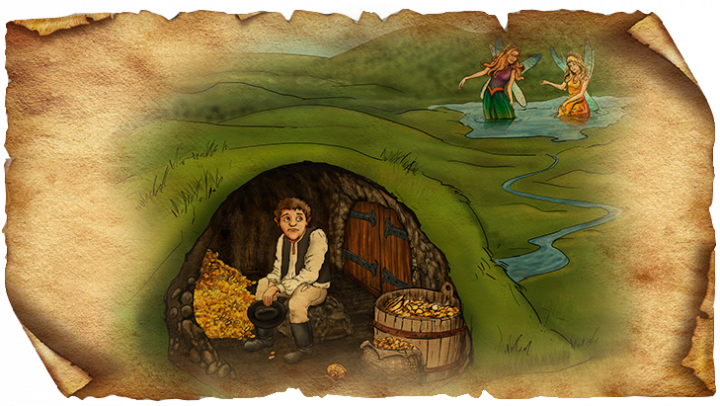The treasure guardian fairies of the Pagan Fortress - Band

The hill named Pagan Fortress rises between Mezőbánd and Mezősámsond, and although it is used today as a farmland, it is believed that from time immemorial, fabulous treasure is hidden in a secret cellar. Once there was a castle at this place: castle of Sámsond / Șincai, where the name of the small town comes from.
The folk tradition says that the inhabitants of the castle, according to ancient religion, presented sacrifice here to their Warlord long time ago. The treasures of the castle were hidden at a safe place in a secret cellar under the fortress. But the old people also knew that they were guarded by two fairies, and no one dared to search for them, as they could only be lucky when the fairies left the cave for a short time to bathe in the nearby Bándi Lake. Lots of lucky hunters already tried to get the treasures.
A shepherd grazed his flock just near the entrance to the cellar, when the fairies left the treasure unattended, and managed to get into the cavity sealed by the iron door. The lad filled even twice his shepherd coat with gold and gemstone, but his greed drove him back even for the third time - if he gave up on the idea, maybe his great-grandchildren could have lived in a genteel way. The fairies returned to the cellar, and then the door slammed behind them. The shepherd lived in captivity for seven years, without food or water, until the door opened again. As he suddenly got out of the darkness, he lost his sight in the enormous light. He lived his life as a beggar, this is how he was punished for his greed. This, however, did not discourage later treasure hunters from the hillside research - fortunately, they found here artefacts from Avar-age, but archaeological materials from the Bronze and Roman times were also discovered.
Several small villages were merged into the settlement in the 16-17th centuries, among them Székelygerebenes, Adósfalva, Súgófalva, Kistelek, Egerháza, Csükmöd and Rózsásfalva, the remains of a Roman colony were discovered here, and coins were also found under the earth, if these were not even the treasures of the fairies.
Mezőbánd / Band is an important transport hub, as the parish center is crossed by the county roads which lead through Radnót/ Iernut and Nagysármás / Sărmașu to Kolozsvár / Cluj-Napoca. Károly Agyagási, a doctor, poet, translator, Tibor Siklódy Hungarian landscape painter and Eszter Mátéfi handball player were born here. In the boundaries of the settlement, besides the medieval castle mentioned above, there were also old mansion houses, but these are no longer visible, as most of the village burned down in 1857.
If you are traveling as a tourist to Mezőbánd and its surroundings, at the supposed place remember the unlucky shepherd's case and the lesson of his story: a mouthful of bread is worth more than a bag of gold. If we get hungry on the way, fortunately, we could ask for a mouthful of bread from our dear hosts in Mezőbánd / Band.
The folk tradition says that the inhabitants of the castle, according to ancient religion, presented sacrifice here to their Warlord long time ago. The treasures of the castle were hidden at a safe place in a secret cellar under the fortress. But the old people also knew that they were guarded by two fairies, and no one dared to search for them, as they could only be lucky when the fairies left the cave for a short time to bathe in the nearby Bándi Lake. Lots of lucky hunters already tried to get the treasures.
A shepherd grazed his flock just near the entrance to the cellar, when the fairies left the treasure unattended, and managed to get into the cavity sealed by the iron door. The lad filled even twice his shepherd coat with gold and gemstone, but his greed drove him back even for the third time - if he gave up on the idea, maybe his great-grandchildren could have lived in a genteel way. The fairies returned to the cellar, and then the door slammed behind them. The shepherd lived in captivity for seven years, without food or water, until the door opened again. As he suddenly got out of the darkness, he lost his sight in the enormous light. He lived his life as a beggar, this is how he was punished for his greed. This, however, did not discourage later treasure hunters from the hillside research - fortunately, they found here artefacts from Avar-age, but archaeological materials from the Bronze and Roman times were also discovered.
Several small villages were merged into the settlement in the 16-17th centuries, among them Székelygerebenes, Adósfalva, Súgófalva, Kistelek, Egerháza, Csükmöd and Rózsásfalva, the remains of a Roman colony were discovered here, and coins were also found under the earth, if these were not even the treasures of the fairies.
Mezőbánd / Band is an important transport hub, as the parish center is crossed by the county roads which lead through Radnót/ Iernut and Nagysármás / Sărmașu to Kolozsvár / Cluj-Napoca. Károly Agyagási, a doctor, poet, translator, Tibor Siklódy Hungarian landscape painter and Eszter Mátéfi handball player were born here. In the boundaries of the settlement, besides the medieval castle mentioned above, there were also old mansion houses, but these are no longer visible, as most of the village burned down in 1857.
If you are traveling as a tourist to Mezőbánd and its surroundings, at the supposed place remember the unlucky shepherd's case and the lesson of his story: a mouthful of bread is worth more than a bag of gold. If we get hungry on the way, fortunately, we could ask for a mouthful of bread from our dear hosts in Mezőbánd / Band.
